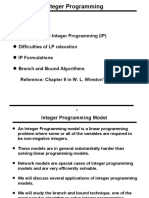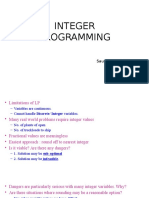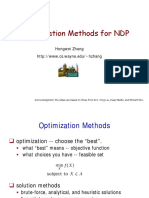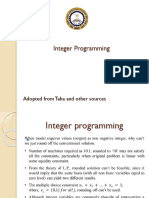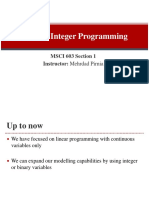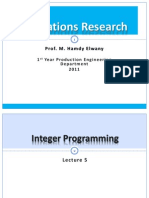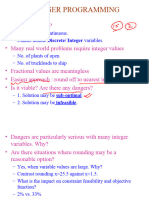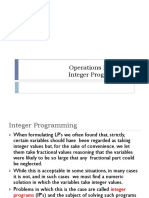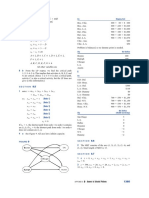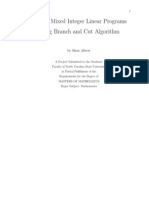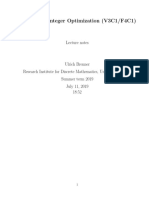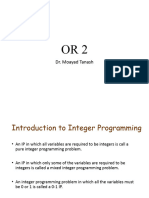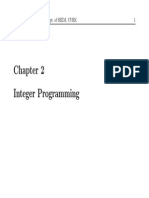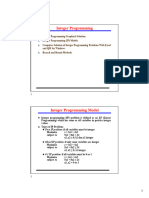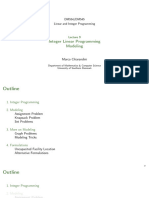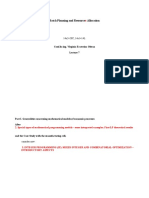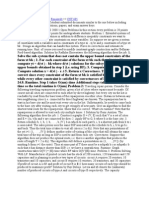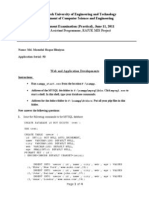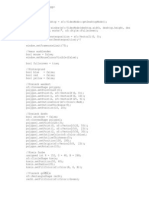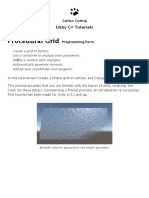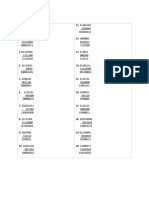Group B
sybqrob.le3
I , Suppose -we have branched 0,-having
TABLE 58
on a subproblem (call it
obtained the following two subproblems:
optimal solution SOLo) 0 + ConstEinr rr 0 + Constrainr rr
ar;;;v;
Subproblem $ublr0bhm Sdpmblm 2. Subproblem some integer).
=, + I (i is ;;
setup cost or'9250 and a per-unit production cost ofg2 are rn-cu.rred. At the end of each period a per_unir holding cost
i.
p,9*
5gbproblem
.
rtsiand
le optimal
I when we ,blem 5 of by choos-
opumat sotution to subproblem I lcall it SOLI) iris xl _ ;r. where.rr< i. For some numberc( 0 < c < I)..(SOL0) C)SOLI will have the following three properties: ' +
havingxl = i and .i?t"ql:T 2 having 11_ -
l!"t q:." will I
exist at least one optimat solution to at least on; optimal solution
inventory level is 0. Each period tial production occurs a
i1
1. lHint: Suppo;
(l a i c
The vatue of .rr in C(SOL0)
equal i.
1t
.c)SOLt will
sub_
at
of $1 is incurred. a Solve for the cost-minimizing production schedule . usrng tle lbllowing decisioo variables: _r, = unil.s pro_
_c(SOL0) problem l.
(l -
c)SOLI will be feasible in
The z-lalue for c{SOL0)
least as good as the z-value
r (l - C)SOLI will be for SOLI.
b . Solve the cost-minimiziDg produclion schedule -for usng Oe following variables: y,.s difined in part and x" = number_of unils produced during period i 1a.1 sat_ to lsty penod , demand.
mon*r = I if -y 1f:9 dunng period ,.r and J.,, otherwise. *trs *" iioouced 9*", /, -_ 0
o Options
hen a fea-
Explain how this result can help when we graphically solve lnoch-and-boutrd problems.l
to solve?
Wlich formulation took LINDO or LINGO
less time
nl
z-yalue
During the next five periods, the demands h Table 5g be met on time. At the beginning of period l, the
tnyu.": of why rhe part (b) for1..,9i:. "xptanarion mutatton is solved faster than lhe pan (a) formuiaiion.
lor the LP
;asible inwe solved = 35, on
e.4
TIB Branch-and-Eound llrlethod lor $olving l4ixed lnleger programming pmblems
Recall that, in a mixed If, some variables are required to be integers and others are al_ lowed to be either integers or nonintegers. To solve urnk"a n Ly-tf," Uranch_and-bound method, modig, the method describetin Section 9.3 Uy variables that are required to be integers. Also, for a solution," ,rup."ir"- ?"".,V a candidate solube tion,.it need only assign integer values to.tf,o""_uUulf"r'tfiul'ar" " .lq";r"0," be integers. To illustrate, Ier us solve the following mixed Ip:
IC
arl
lr_"iir!
.,
maxz:2xt + x.z
s-t.
x1, .r2
5x1 )_ 2x2
x1
<g x233
0; x1 integer
subproblem 2 is the candidate sorution z 3. x1 0, x2 3. we now solve suuproir". ouhin the can_ didale sorution z 1,,, = t. x, = ).me,-varr; r canoraare e,._ ceeds the z-vatue for-the subprobiem c-aiaut", .o ,uip.o from and-the subprobrem 3 caadidate (" ""#'i" "ri.irated = ::::id:*.,j-,mixed Ip the optimal soruhon to the
As before, we begin by solving the Lp reraxation of the Ip rhe optimar solution of the LP relaxal.ion is z : j.,, i,*, = i. Because x, is ajlowed to ul nactlona, wedo nol branch on x2; if we did so, we would b'e excluding-poil;".d;lr"s between 2 and 3, and we don't want to do that. Thus, we must branch on.r1. This yields subproblems 2 and 3 in Figure 21. We, next choose to solve subproblem 2. The optimal solution to
;;il';l;;;irJ,n
",ii I,i, :'t,.r:;iis
i-a
I .4
ne 0mllclrrd.0ol|d tteh0d l0r $0hiry Llired lnbpr
fmgraln|llir0 pmthlns
523
�In the cheapest-insertion heuristic (CIH), we begin at any city and neighbor. Then we create a subtour joining those two cities. Next, ',a,6 the subtour [say, arc (r,l)] by the combination of two arcs-1i, f) and ( not in the cwrent subtour-that will. increase the lengh ofthe subtour bv cheapest) amount. We continue with this procedure until a tour is ing this procedure begiruring with each city, we take the best tour found.
lmplicit Enumeration
In a 0-l IP, implicit enumeration may be used to find an optimal solution. ing at a node, create two new subproblems by (for some free variable x) straints .r, : 0 and xi : l. If the best completion of a node is feasible, then
branch on the node. If the best completion is feasible and better than the date solution, then the curent node yields a new LB (in a max problem) and timal. If the best completion is feasible and is not better than the curent tion, then the curent node may be eliminated from consideration. Ifat a given is at least one constaint that is not satisfied by any completion ofthe node, cannot yield a feasible solution nor an optimal solution to the IP.
ecl
&e
eac
Fhe s,
m onro
, lmin
travel
Cub
Cutting Plane Algorithm
step
agent p Sutt
Tim
1 2
Find the optimal tableau for the IP's linear programming relaxation.
If
the nul
are
the most
ables in the optimal solution assume integer values, we have found an optimal the IP; otherwise, proceed to step 2.
vi
Pick a constraint in the LP relaxation optimal tableau whose righthand the ftactional part closest to ]. This conshaint will be used to generate a cut.
Step Step
For the conshaint identified in step 2, wdte its right-hand side and each where 0 ="f < 1. ablet coefrcient in the form [r]
2a
TABLE
+l
Step
2b
Rew te the constmint used to generate the cut
as
I
2
3
All terms with integer coefficients
Then the cut is
all terms with fractional coemcients
All terms with iractional coefficients < 0
Slep Use the clual simplex to find the optimal solution to the LP relaxation, with the cut as an additional constraint. If all variables assume integer values in the optimal solution, then we have found an optimal solution to the IP Otherwise, pick the constraint witlt the most fractional right-hancl side and use it to generate another cut, which is added to the tableau. We continud this process until we obtain a solution in which all variables are integers. This will be an optimal solution to the IP.
TABLE
Dist ct
I
2
3
RItIIEt]l, PROBLIll'lS
Group A
4
5
In the Sailco problem of Section 3.10,
suppose that a
fixed cost of $200 is incurred during each quarter that
production talies place. Formulate an IP to minimize Sailco's total cost of meeting the demands for the four quarters.
piecewise linear functions
piecewise linear functions.)
Explain how you would use inleger programming and to solve the follo!4lnt optimization prcblem. (ffirr. Approximate f a114 y2 b!
lBased lBased
o
o
clllPTfl
lllbger Pmumlllmillg
�closest
1
alc in ele /r iS
llest (or
s.t-
ma*z:3? + f x+ y=l x,y>0
TABLE 9'
Dislrict
I
2
3
School
tlish i
I
0.5
fiish
School 2
r apply-
The Transyllania Olympic Cymnasrics Team consists of six people. Transylvania must choose three people to enter both the balarce beam and floor elrcrcises. They must also enter a total offour people in each event. The score that irdividual g]4nnasl can attain in each event is shown "66tr in Table 89. Formulate an [P ro maximize rhe rotal score aMined by the Transylvania gymnasts.
3-
2 t.'7 0.8
0.8
1.3 1.5
4
5
0.4
0.6
branch-
41 6 court decision
gh school
ing
conneed not
has stated that the enrollment of each in Metropolis must be at least 20 percenr black. fte numbers of black and white high school srudents in
eaoh
TABLE 92
nt candiay be op-
late solurde, there
r
(in miles) that a student ir each distdct must travel to each high school is shown in Table 91. School 66ud policy requires that all the students in a giver district n69nd the same school. Assuming that each school must
The distance
have an
of the
cityt
five school districts are shown in Table 90.
RS
BS
4
3
enrollrnent ofat least 150 students, formulate ar IP
DE
ST TS
the node
lhat will minimize the total distance that Metropolis students must havel to high school.
z
2
6 (richty) 5 (dchty) 3 (righty) 3 (lefty) 2 (righty)
The Cubs are trying to determine which ofthe following te agent pitchers should be signed: Rick Sutcliffe (RS), Bruce
If
all vari.
Suttn (BS), Dennis Eckersley (DE), Steve Trout Tim Stoddard (TS). The cost of signing each pitcher 6T), and the number of victories each pitcher will add to the oubs are shown in Table 92. Subject to the following
solution to
Fstrictions, the Cubs want to sign the pitchers who will add '.ile most victories to the team.
a t c d
slgll
At most, $12 million can be spent.
If DE
and ST arc signed, then BS canaot be signed.
At most two right-handed pitchers can be signed.
The Cubs carmot sign both BS and RS.
Formulate an IP to help the Cubs determine who they should
rd side has
BLE 89
t each vari-
State
Unive6ity must puchase 1,100 computers from
three vendors. Vendor
charyes $500 per computer plus a
delivery charge of $5,000. Vendor 2 charyes $350 per
ients
8.8 9.4
9.2 7.5 8.1
9-1
7.9 8.3 8.5 8.7
8.1
computer plus a delivery charge of $4,000. Vendor 3 chaiges $250 per computer plus a delivery charge of $6,000. Vendor I will sell the university at most 500 computem; vendor 2, at most 900; and vendor 3, at most 400. Formulate aIl IP to minimize the cost ofpurchasing the needed computerc.
Use the branch-and-bound method to solve the following IP:
8.6
m?Lxz=3tr+x2
on, with
the
s.t, 8
5xt + x2
2x1
)Dtimal solu,nstraint with
to ;r is added
* x238
12
xr, x2 > 0; rt, x2 ir'teget Use the branch-and-bound method to solve the follow-
vadabls ale
80
'70
ing IP:
mitrz:3x1 *x2
30
5
s.t.
2.xr
90
50 60
l0
40
30
9 Use the branch-and-bound method to solve the followirg IP:
maxz = xr +
2,a2
xr+x2=4 xt, x2 > 0; ,r integer
x2
,,r#.ili1&q4
s.t.
. rz and!
"'
xt, )b
Jr2 = l0 2\+5x2<30
,l +
>
0; xr, x2 i,,tqBet
RsYie[ Pmblelns
553

